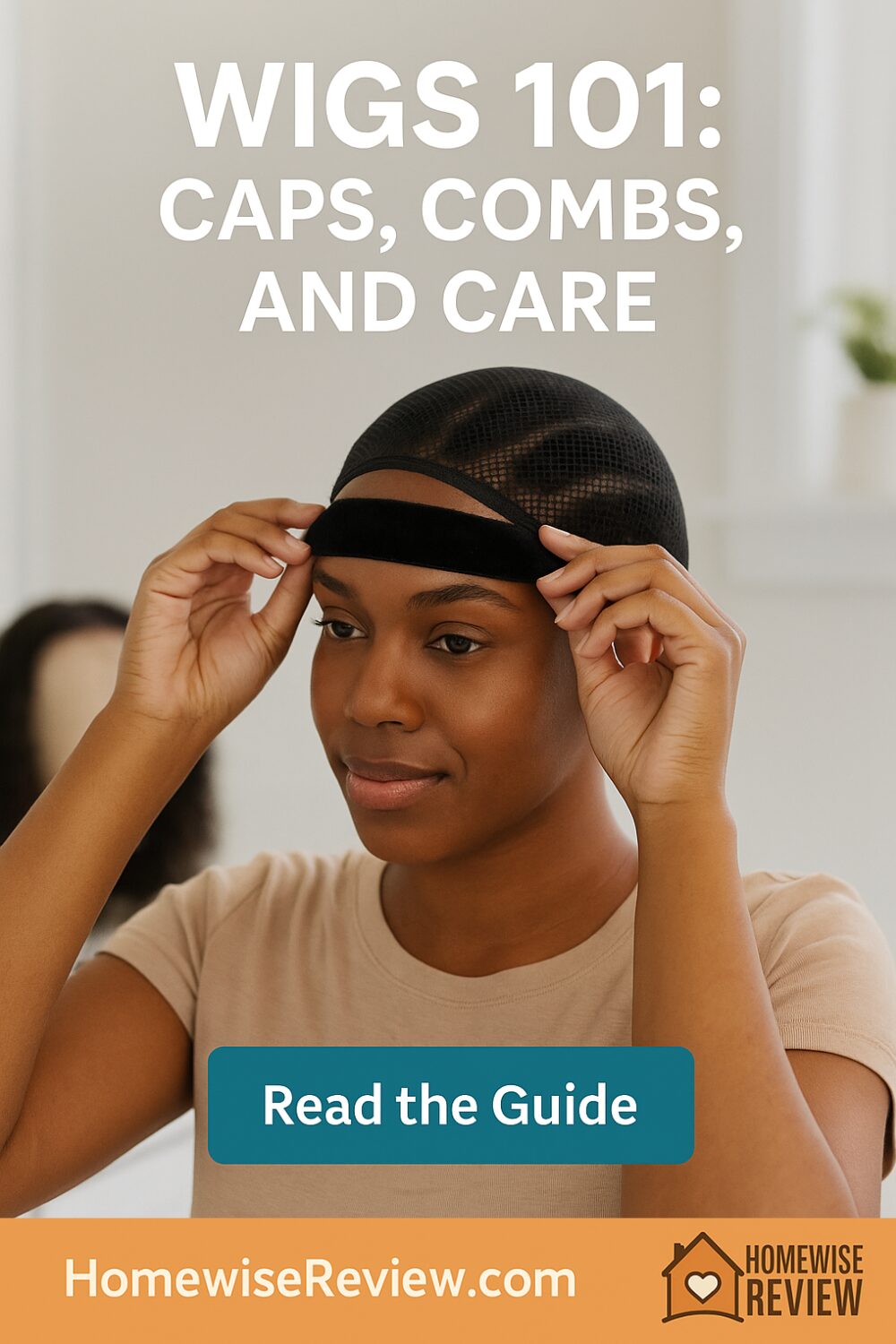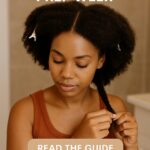
Secure, comfy, and scalp-friendly from install to takedown.
Wigs can be a protective style that buys you time and flexibility. The goal is comfort, clean roots, and a secure fit without stressing your hairline. This guide explains cap types, combs and grips, simple installation, daily care, and the takedown routine that keeps natural hair thriving.
What you’ll need
- Wig cap that suits your needs: nylon stocking, mesh, or dome
- Wig with built-in combs or clips, or an elastic band/grip
- Sectioning clips, soft brush, and a wide-tooth comb
- Lightweight scalp serum and a leave-in for ends
- Satin or silk scarf and pillowcase for night
- Optional: wig grip band, needle and thread to move combs, adhesive remover if you use glue
Steps
- Prep your base
- Cleanse, condition, and fully dry hair. Cornrow, flat twists, or low braids in a pattern that distributes tension.
- Smooth flyaways with a light leave-in. Avoid heavy oils on the scalp.
- Why it matters: a dry, clean base prevents itch and odors under the unit.
- Pick the right cap
- Nylon stocking cap: thin and flat, great for a sleek base. Can feel warm.
- Mesh cap: more breathable, easier scalp access for serum.
- Dome cap: thicker fabric for glueless installs or making wigs.
- Fit should be snug, not tight. If edges feel squeezed, size up.
- Why it matters: breathability and fit decide comfort and longevity.
- Secure gently
- If the wig has combs, place them behind the hairline and into braids, not directly on fragile edges.
- Prefer wig grip bands or an adjustable elastic band for glueless security.
- If using adhesive, patch test and use sparingly at the front only.
- Why it matters: less stress on edges and fewer tension headaches.
- Line up and blend
- Place the wig slightly in front of your hairline, then settle it back to the line.
- For lace, trim small amounts at a time. Melt with a light spray if needed.
- Blend parting with a small brush and powder that matches your scalp tone.
- Daily care routine
- Air out the wig after wear. Brush from ends up.
- Lift the unit to ventilate the scalp and apply a few drops of serum along parts if needed.
- Sleep with the wig off when possible. Store on a stand. If you sleep in it, use a satin scarf and pillowcase.
- Weekly refresh
- Clean the hairline of the unit with a gentle remover.
- Wash the wig as directed by fiber type. Allow to air dry on a stand.
- Clean your cap or swap for a fresh one.
- Safe takedown
- Remove adhesive with remover and patience. Never rip.
- Undo base braids, detangle with slip, and cleanse the scalp.
- Assess edges. If tender, rest from tight styles for a week.
When to reach for which cap and secure method
- Hot climates or gym days: Mesh cap + wig grip for airflow.
- Very fine edges or recovering hairline: Skip front combs. Use grip plus elastic band.
- All-day wear: Mesh or thin nylon with periodic scalp breaks.
- Short wear, quick swaps: Nylon cap for the flattest base.
- Sensitive skin: Glueless setup with grip band and adjustable straps.
Product picks (4)
1) Breathable Mesh Wig Cap
Why it works: Improves airflow and lets you access parts for serum.
How to use: Stretch gently over cornrows. Replace when stretched out.
Keep in mind: Not as flat as nylon, so smooth hair underneath well.
Who it’s for: Hot sleepers, gym days, sensitive scalps.
2) Velvet Wig Grip Band
Why it works: Adds non-slip security without combs or glue.
How to use: Wear just behind the hairline, nap facing the right direction per brand.
Keep in mind: If too tight, size up to protect edges.
Who it’s for: Anyone avoiding adhesive or with fragile hairlines.
3) Small Sew-In Wig Combs Kit
Why it works: Lets you move combs away from edges to safer anchor points.
How to use: Stitch combs into the wig’s interior where your braids sit.
Keep in mind: Do not pierce lace fronts near the edge.
Who it’s for: Users who want light mechanical hold without glue.
4) Lightweight Scalp Serum
Why it works: Soothes dryness and itch under units without heavy residue.
How to use: A few drops along parts every 2–3 days as needed.
Keep in mind: Avoid thick oils that trap lint.
Who it’s for: Long wearers, dry climates, sensitive scalps.
Quick fixes vs long-term habits
- Quick fix: If the front feels tight mid-day, shift the grip back 2–3 mm and massage the hairline lightly.
- Long-term: Rotate wig-free nights, cleanse weekly, and avoid permanent tension on the same spots. Move combs and vary parts.
Match by hair type and lifestyle
- Type 3 curls: Flat twists or two-strand base is usually enough. Use nylon cap for sleekness.
- Type 4 coils and 4C: Cornrow base in small, even rows. Mesh cap for airflow.
- Low porosity: Keep leave-in light so hair does not feel coated under the cap.
- High porosity: Seal ends lightly before braiding the base.
- Locs: Choose oversized caps and glueless grips. Avoid catching locs in combs.
Storage and maintenance schedule
- Detangle the unit after each wear and air dry on a stand.
- Wash human-hair wigs every 7–10 wears and synthetic every 10–15, or sooner if products build up.
- Replace stretched caps every few weeks. Inspect straps and move combs when needed.
Final Thoughts
A comfortable wig starts with a clean, dry base and gentle security. Choose the cap that matches your climate and scalp, rely on grips or adjusted bands over glue when you can, and give your hairline regular breaks. With a simple weekly refresh and smart storage, your unit lasts longer and your natural hair stays healthy.
See also
If you are building a full protective routine around wigs, start with Natural Hair Products | Best Picks for Coils, Curls, Kinks for caps, grips, and gentle serums that pair well with long wear. For a healthier base before installation, follow Protective Style Prep Week: Trim, Treat, Protect to balance protein and moisture and set a clean grid.
Once you are wearing the unit, keep roots happy with Scalp Care Under Wigs Keep Growth Going and protect your hairline using Edge Care Routine for Protective Styles: reduce tension and thinning. When it is time to wash everything out, Find the Right Shampoo for Your Hair and Scalp helps you reset without stripping.
FAQs
1) Do I have to wear a wig cap if my hair is short?
No, but a thin cap can improve comfort and hygiene. Try mesh for breathability.
2) Are wig grips safe for edges?
Yes when sized correctly and worn just behind the hairline. If you see dents or soreness, loosen or size up.
3) Is glue necessary for lace fronts?
Not always. Many users secure with a grip and elastic band. Use adhesive only when needed and remove with proper remover.
4) How do I stop itch under a wig?
Clean base, breathable cap, and minimal product. Ventilate the scalp daily and add a few drops of lightweight serum along parts.
5) Can I sleep in my wig?
You can, but off is better. If you keep it on, wrap with a satin scarf and use a satin pillowcase to reduce friction.
Affiliate Disclosure
If you purchase through links on our site, we may earn a small commission at no extra cost to you.




